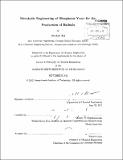| dc.contributor.advisor | Gregory N. Stephanopoulos. | en_US |
| dc.contributor.author | Tai, Mitchell | en_US |
| dc.contributor.other | Massachusetts Institute of Technology. Dept. of Chemical Engineering. | en_US |
| dc.date.accessioned | 2013-01-23T19:43:08Z | |
| dc.date.available | 2013-01-23T19:43:08Z | |
| dc.date.copyright | 2012 | en_US |
| dc.date.issued | 2012 | en_US |
| dc.identifier.uri | http://hdl.handle.net/1721.1/76486 | |
| dc.description | Thesis (Ph. D.)--Massachusetts Institute of Technology, Dept. of Chemical Engineering, 2012. | en_US |
| dc.description | Cataloged from PDF version of thesis. | en_US |
| dc.description | Includes bibliographical references. | en_US |
| dc.description.abstract | The past few years have introduced a flurry of interest over renewable energy sources. Biofuels have gained attention as renewable alternatives to liquid transportation fuels. Microbial platforms for biofuel production have become an attractive option for this purpose, mitigating numerous challenges found in crop-based production. Towards this end, metabolic engineering has established itself as an enabling technology for biofuels development. In this work we investigate the strategies of metabolic engineering for developing a biodiesel production platform, utilizing the oleaginous yeast Yarrowia lipolytica as the host organism. We establish new genetic tools for engineering Y. lipolytica beginning with an expression vector utilizing the genetic features from translation elongation factor 1-a (TEF). Additionally, a complementary plasmid was developed allowing for multiple plasmid integration. Bioinformatics analysis of intronic genes in hemiascomycetous yeast also identified relationships between functional pathways and intron enrichment, chronicling the evolutionary journey of yeast species. Next gene targets were examined within the lipid synthesis pathway: acetyl-coA carboxylase (ACC), delta9-desaturase (D9), ATP citrate lyase (ACL), and diacylglycerol acyltransferase (DGA). A combinatorial investigation revealed the order of contribution to lipid overproduction (from strongest to weakest): DGA, ACC, D9, ACL. Scale-up batch fermentation of selected strains revealed exceptionally high lipid accumulation and yield. These results demonstrate the balance between cellular growth and lipid production which is being modified through these genetic manipulations. We next explored utilization of alternative substrates to expand the capabilities and utility of Y. lipolytica. For xylose, a prevalent substrate in cellulosic feedstocks, expression of the redox pathway from Scheffersomyces stipitis and adaptation led to successful substrate utilization. Through the use of cofermentation, growth and productivity on xylose was improved dramatically with xylose-to-lipids conversion successfully demonstrated. For acetate, a potentially useful substrate for electrofuel production, lipid production using our strongest performing strain resulted in high lipid accumulation and yield. From this study, metabolic engineering of Y. lipolytica was successfully used to achieve exceptional lipid overproduction from a variety of substrates. Our genetic tools and recombinant strains establish a strong platform for the study and development of microbial processes for the production of biofuels. | en_US |
| dc.description.statementofresponsibility | by Mitchell Tai. | en_US |
| dc.format.extent | 220 p. | en_US |
| dc.language.iso | eng | en_US |
| dc.publisher | Massachusetts Institute of Technology | en_US |
| dc.rights | M.I.T. theses are protected by
copyright. They may be viewed from this source for any purpose, but
reproduction or distribution in any format is prohibited without written
permission. See provided URL for inquiries about permission. | en_US |
| dc.rights.uri | http://dspace.mit.edu/handle/1721.1/7582 | en_US |
| dc.subject | Chemical Engineering. | en_US |
| dc.title | Metabolic Engineering of oleaginous yeast for the production of biofuels | en_US |
| dc.type | Thesis | en_US |
| dc.description.degree | Ph.D. | en_US |
| dc.contributor.department | Massachusetts Institute of Technology. Department of Chemical Engineering | |
| dc.identifier.oclc | 822561377 | en_US |
